Bangkok
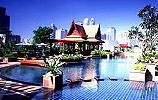
| 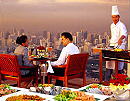
| Bangkok Hotels | 
| 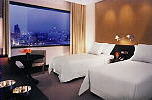
|
Sights
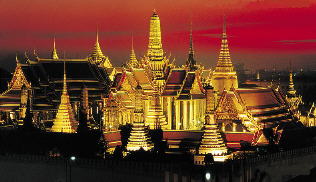
|
The Emerald Buddha This is a Buddha image in the meditating position in the style of the Lanna school of the north, dating from the 15th century AD. King Rama I brought it from Vientiane , and it is considered to be the most important Buddha image in the country.
Model of Angkor Wat King Rama IV had this built by Phra Samphopphai when Cambodia was under Siamese control. The model was recreated in plaster at the behest of King Rama V to celebrate the first centenary of the Royal city.
Prasat Phra Thepidon This four-square prang originally called "Puttaprang Prasat" was built in the reign of King Rama IV. Inside are statues of Kings Rama I-King Rama VIII, to which the public pay their respects on Chakri Day, April 6, every year.
Mondop This structure stands behind Prasat Phra Thepidon, and was built in the reign of King Rama I. Inside is a cabinet holding the Buddhist scriptures beautifully decorated in mother-of-pearl.
Balcony This can be compared to the temple wall. The murals inside tell the Ramayana story in its entirety. On the columns of the balcony are stone inscriptions of the verses describing the murals.
Phra Sri Ratana Chedi Built in the style of Wat Sri Sanphet in Ayutthaya , this chedi is to the west of the Monhop. Inside is a small chedi with relics of the Lord Buddha.
Phra Atsada Maha Chedi This group of eight chedis stands in front of the temple. It was built in the reign of King Rama I and dedicated to the heavens. Six of the group are outside the balcony, two are inside. Each has its own name.
Yaksa Tavarnbal (Gate-keeping Giants) Six pairs of mythical ogres stand at each gate of the Balcony. These are the main Giants of the Ramayana.
Hor Phra Khanthan-rat Standing in the estern corner of the balcony, this is where the Phra Puttakhanthan-rat figure is enshrined. It presides over the Royal rain-making ceremony and the ceremony of the first rice planting. Inside are paintings by the mural artist Khrua In Khong.
Hor Phra Ratcha Karamanusorn Inside this structure are 34 Buddha images in various positions, built by command of King Rama III and dedicated the kings of Ayutthaya and Thonburi.
Hor Phra Ratcha Pongsanusorn Built in the reign of King Rama IV, this is the location of the Buddha image of the reigning King of the Rattanakosin Era. Inside are murals of Royal chronicles of Ayutthaya by Khrua In Khong.
Hor Phra Nak Situated behind the temple, this traditional Thai building roofed with glazed tiles contains the ashes of the Royal family.
Address: Na Phralan Road, Phra Borommaharatchawang Sub-District, Phra Nakhon District Bangkok 10200
Tel: (662) 222-8181: 3801 3890 / 222-2208 623-5500: 3100
Bus No.: 1 3 6 9 15 19 25 30 32 33 39 43 44 47 53 59 60 64 65 70 80 82 91 123 201 203; Air-con Bus: 1 8 25 506 507 512 Sai 38 39 44
Pier: Chao Phraya Express Boat: Tha Chang Pier
Opening Hours: Daily 8 am-4 pm
Admission Fee: Foreigner 200 Bht
Guide: 10 am 2 pm Personal Audio Guide (PAG): German, English, French, Japanese, Mandarin, Russian, Spain, Thai
Admission Fee: 100 Bht/2 hours Passport/Credit card - Tel: (662) 222-2208
Coffee Shop / Restaurant: Sala Atthawichan
Prohibited: Taking photo inside the ubosot. Unobtrusive dress required.
Parking: Ratchavoradit Pier, Snam Luang, Wat Mahathat
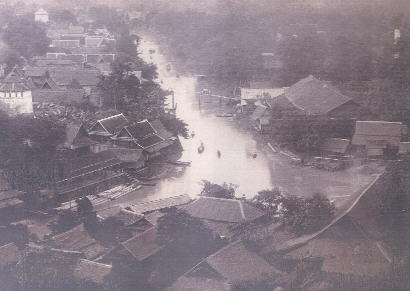
|
In the evening of the twenty-ninth of August we already entered the Menam, the wealth providing "Nile of Siam", and anchored in front of the harbour of Bangkok, Paknam, after we have sailed through the infamous bar. ... Because the lighthouse of the Siamese government at the bar was no longer satisfactory for the increased shipping traffic, the management of the Norddeutschen Lloyd, which does almost all the transportation of travellers with Bangkok, has anchored a lightship here. ... Unfortunately, I was not able to make the interesting journey from Paknam to Bangkok by day. In addition, in the evening, a really unpleasant tormentor in the shape of Anopheles, the vector of Malaria, appeared so that we had to flee early behind our mosquito nets. When I woke up from disturbing dreams, we had already reached Bangkok. The ship anchored by 7 a.m. First a few Siamese in their becoming national dress came aboard: white low shoes, white knee-high stockings, a blue sarong pulled together into knickerbockers in front and back leaving free part of the upper thighs - the so-called panung - and above it a becoming white jacket.
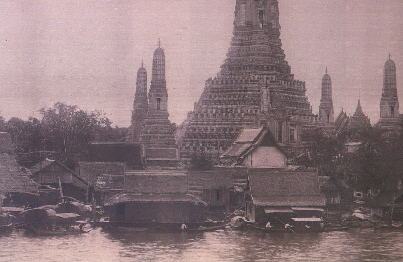
|
What a surprise: the electric tramway drove smoothly alongside me! That Bangkok has a tram is due to the active mind of a Dane, Admiral Richelieu du Plessis, the former commander of King Chulalongkorn's flagship. My hotel looked little enticing; over a rickety staircase one reached a passable room. The service is in the hands of a Thai woman; for the first time since long, tea is again presented by a woman. Admittedly the slender Hebe leaves much to be desired according to European taste. The opened mouth shows a brown-red pulpy mass, which begs the question whether there are any teeth at all. The features are not uninteresting, the stature half tall, rather than short.
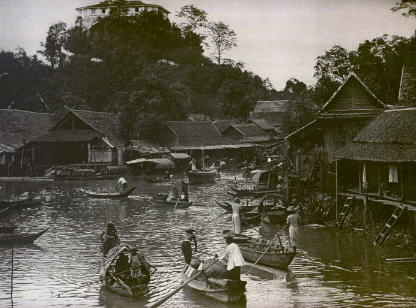
|
Abstract of "Through King Chulalongkorn's Kingdom" by Carl Curt Hosseus (1904).
|
Bangkok
 |
